University Case Study: NUR231 Patient Care and Medication
VerifiedAdded on 2022/08/22
|11
|2612
|13
Case Study
AI Summary
This case study presents a detailed analysis of a patient scenario, addressing various medical conditions and nursing interventions. It begins by defining key terms such as tachycardia, tachypnea, angina, hypertension, anxiety, and tremor, and then provides observed data including blood pressure and respiratory rate. The solution outlines immediate nursing actions, including blood pressure reduction, oxygen support, and mental health assessment, alongside medication management for conditions like tremor. The pathophysiology of asthma, including the roles of inflammation, bronchoconstriction, and various stimuli, is thoroughly discussed. The case study further explores the pharmacology of medications such as Albuterol (Ventolin), Salmeterol (Serevent), and Ipratropium (Atrovent), and their application in treating respiratory conditions. Additionally, it covers Graves' disease, an autoimmune disorder causing hyperthyroidism, explaining its underlying mechanisms and the role of anti-thyroid drugs like Propylthiouracil (PTU) and Methimazole (MMI), along with beta-blockers. The solution emphasizes the importance of adhering to the NMBA code of practice for registered nurses, highlighting the significance of patient-centered care, effective communication, and appropriate medication choices, particularly in the context of pregnancy and the potential interactions between bronchodilators and beta-blockers.
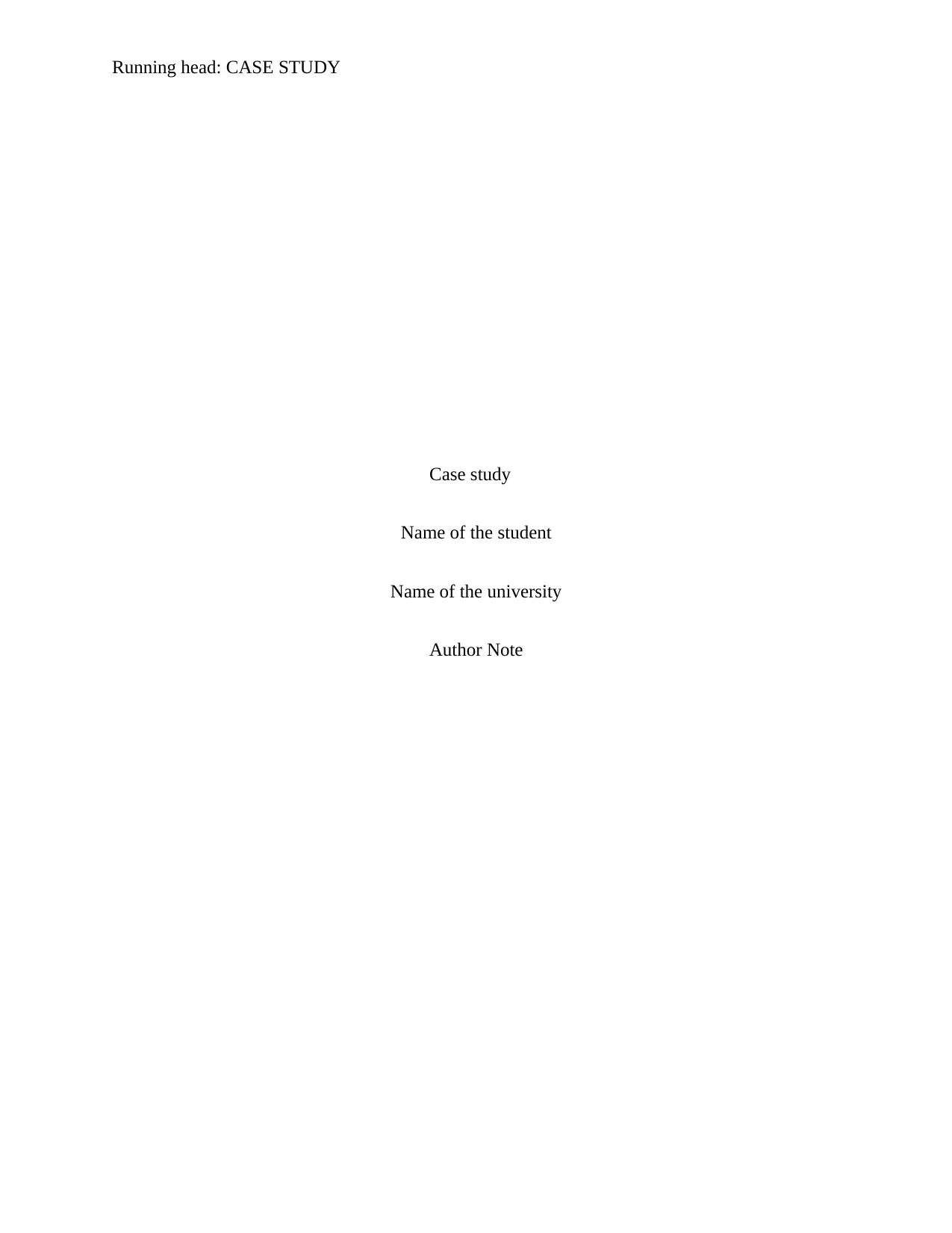
Running head: CASE STUDY
Case study
Name of the student
Name of the university
Author Note
Case study
Name of the student
Name of the university
Author Note
Paraphrase This Document
Need a fresh take? Get an instant paraphrase of this document with our AI Paraphraser
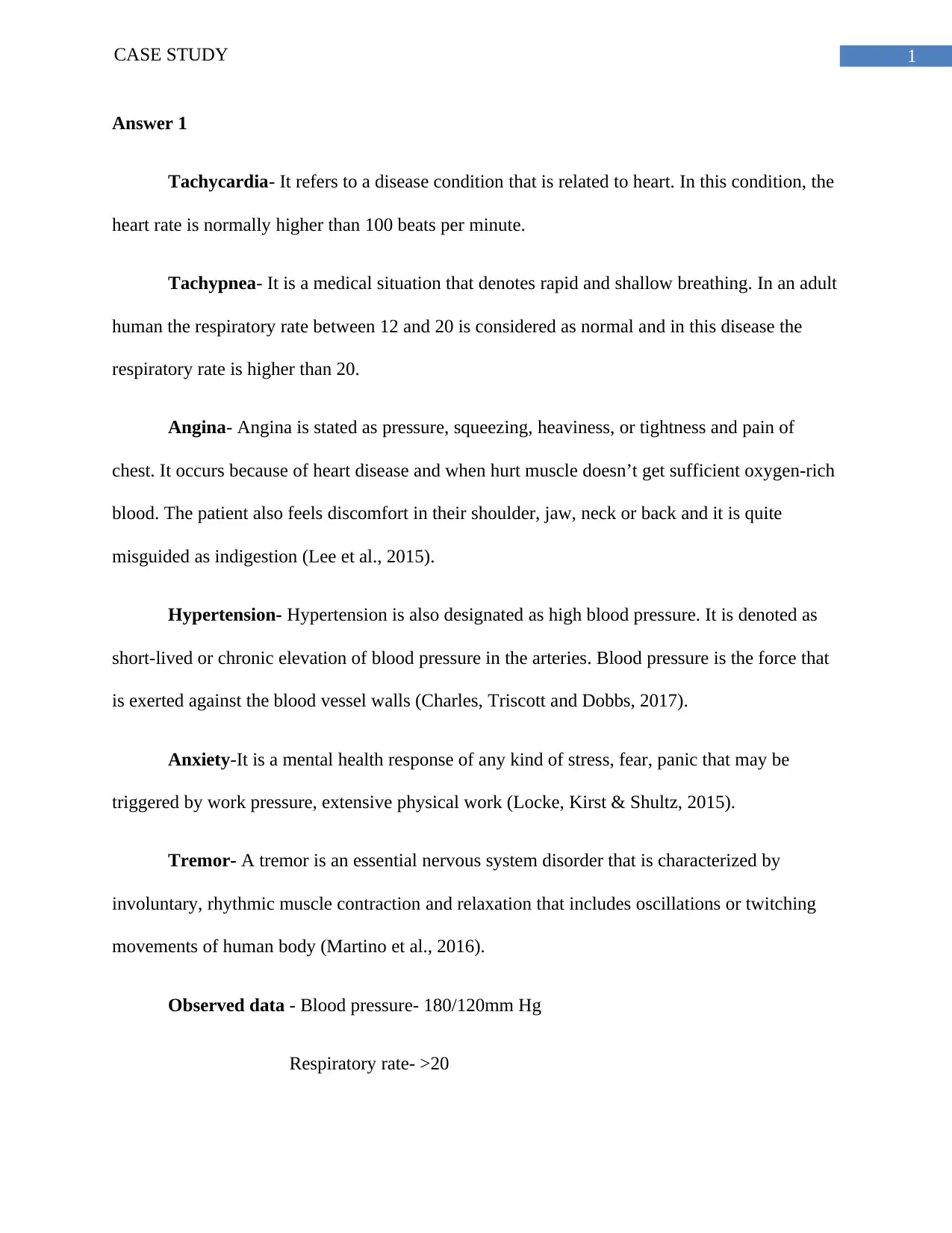
1CASE STUDY
Answer 1
Tachycardia- It refers to a disease condition that is related to heart. In this condition, the
heart rate is normally higher than 100 beats per minute.
Tachypnea- It is a medical situation that denotes rapid and shallow breathing. In an adult
human the respiratory rate between 12 and 20 is considered as normal and in this disease the
respiratory rate is higher than 20.
Angina- Angina is stated as pressure, squeezing, heaviness, or tightness and pain of
chest. It occurs because of heart disease and when hurt muscle doesn’t get sufficient oxygen-rich
blood. The patient also feels discomfort in their shoulder, jaw, neck or back and it is quite
misguided as indigestion (Lee et al., 2015).
Hypertension- Hypertension is also designated as high blood pressure. It is denoted as
short-lived or chronic elevation of blood pressure in the arteries. Blood pressure is the force that
is exerted against the blood vessel walls (Charles, Triscott and Dobbs, 2017).
Anxiety-It is a mental health response of any kind of stress, fear, panic that may be
triggered by work pressure, extensive physical work (Locke, Kirst & Shultz, 2015).
Tremor- A tremor is an essential nervous system disorder that is characterized by
involuntary, rhythmic muscle contraction and relaxation that includes oscillations or twitching
movements of human body (Martino et al., 2016).
Observed data - Blood pressure- 180/120mm Hg
Respiratory rate- >20
Answer 1
Tachycardia- It refers to a disease condition that is related to heart. In this condition, the
heart rate is normally higher than 100 beats per minute.
Tachypnea- It is a medical situation that denotes rapid and shallow breathing. In an adult
human the respiratory rate between 12 and 20 is considered as normal and in this disease the
respiratory rate is higher than 20.
Angina- Angina is stated as pressure, squeezing, heaviness, or tightness and pain of
chest. It occurs because of heart disease and when hurt muscle doesn’t get sufficient oxygen-rich
blood. The patient also feels discomfort in their shoulder, jaw, neck or back and it is quite
misguided as indigestion (Lee et al., 2015).
Hypertension- Hypertension is also designated as high blood pressure. It is denoted as
short-lived or chronic elevation of blood pressure in the arteries. Blood pressure is the force that
is exerted against the blood vessel walls (Charles, Triscott and Dobbs, 2017).
Anxiety-It is a mental health response of any kind of stress, fear, panic that may be
triggered by work pressure, extensive physical work (Locke, Kirst & Shultz, 2015).
Tremor- A tremor is an essential nervous system disorder that is characterized by
involuntary, rhythmic muscle contraction and relaxation that includes oscillations or twitching
movements of human body (Martino et al., 2016).
Observed data - Blood pressure- 180/120mm Hg
Respiratory rate- >20
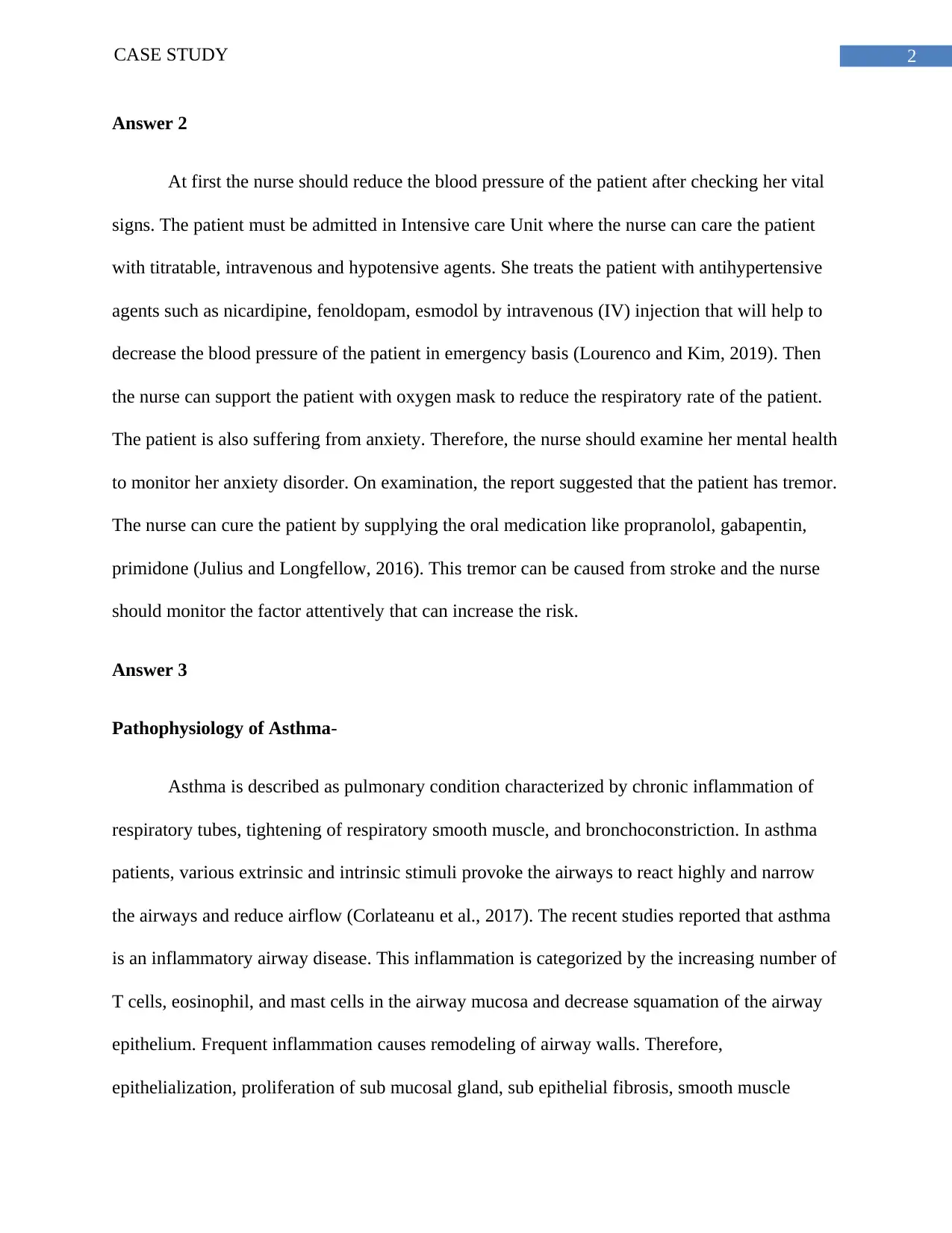
2CASE STUDY
Answer 2
At first the nurse should reduce the blood pressure of the patient after checking her vital
signs. The patient must be admitted in Intensive care Unit where the nurse can care the patient
with titratable, intravenous and hypotensive agents. She treats the patient with antihypertensive
agents such as nicardipine, fenoldopam, esmodol by intravenous (IV) injection that will help to
decrease the blood pressure of the patient in emergency basis (Lourenco and Kim, 2019). Then
the nurse can support the patient with oxygen mask to reduce the respiratory rate of the patient.
The patient is also suffering from anxiety. Therefore, the nurse should examine her mental health
to monitor her anxiety disorder. On examination, the report suggested that the patient has tremor.
The nurse can cure the patient by supplying the oral medication like propranolol, gabapentin,
primidone (Julius and Longfellow, 2016). This tremor can be caused from stroke and the nurse
should monitor the factor attentively that can increase the risk.
Answer 3
Pathophysiology of Asthma-
Asthma is described as pulmonary condition characterized by chronic inflammation of
respiratory tubes, tightening of respiratory smooth muscle, and bronchoconstriction. In asthma
patients, various extrinsic and intrinsic stimuli provoke the airways to react highly and narrow
the airways and reduce airflow (Corlateanu et al., 2017). The recent studies reported that asthma
is an inflammatory airway disease. This inflammation is categorized by the increasing number of
T cells, eosinophil, and mast cells in the airway mucosa and decrease squamation of the airway
epithelium. Frequent inflammation causes remodeling of airway walls. Therefore,
epithelialization, proliferation of sub mucosal gland, sub epithelial fibrosis, smooth muscle
Answer 2
At first the nurse should reduce the blood pressure of the patient after checking her vital
signs. The patient must be admitted in Intensive care Unit where the nurse can care the patient
with titratable, intravenous and hypotensive agents. She treats the patient with antihypertensive
agents such as nicardipine, fenoldopam, esmodol by intravenous (IV) injection that will help to
decrease the blood pressure of the patient in emergency basis (Lourenco and Kim, 2019). Then
the nurse can support the patient with oxygen mask to reduce the respiratory rate of the patient.
The patient is also suffering from anxiety. Therefore, the nurse should examine her mental health
to monitor her anxiety disorder. On examination, the report suggested that the patient has tremor.
The nurse can cure the patient by supplying the oral medication like propranolol, gabapentin,
primidone (Julius and Longfellow, 2016). This tremor can be caused from stroke and the nurse
should monitor the factor attentively that can increase the risk.
Answer 3
Pathophysiology of Asthma-
Asthma is described as pulmonary condition characterized by chronic inflammation of
respiratory tubes, tightening of respiratory smooth muscle, and bronchoconstriction. In asthma
patients, various extrinsic and intrinsic stimuli provoke the airways to react highly and narrow
the airways and reduce airflow (Corlateanu et al., 2017). The recent studies reported that asthma
is an inflammatory airway disease. This inflammation is categorized by the increasing number of
T cells, eosinophil, and mast cells in the airway mucosa and decrease squamation of the airway
epithelium. Frequent inflammation causes remodeling of airway walls. Therefore,
epithelialization, proliferation of sub mucosal gland, sub epithelial fibrosis, smooth muscle
⊘ This is a preview!⊘
Do you want full access?
Subscribe today to unlock all pages.

Trusted by 1+ million students worldwide
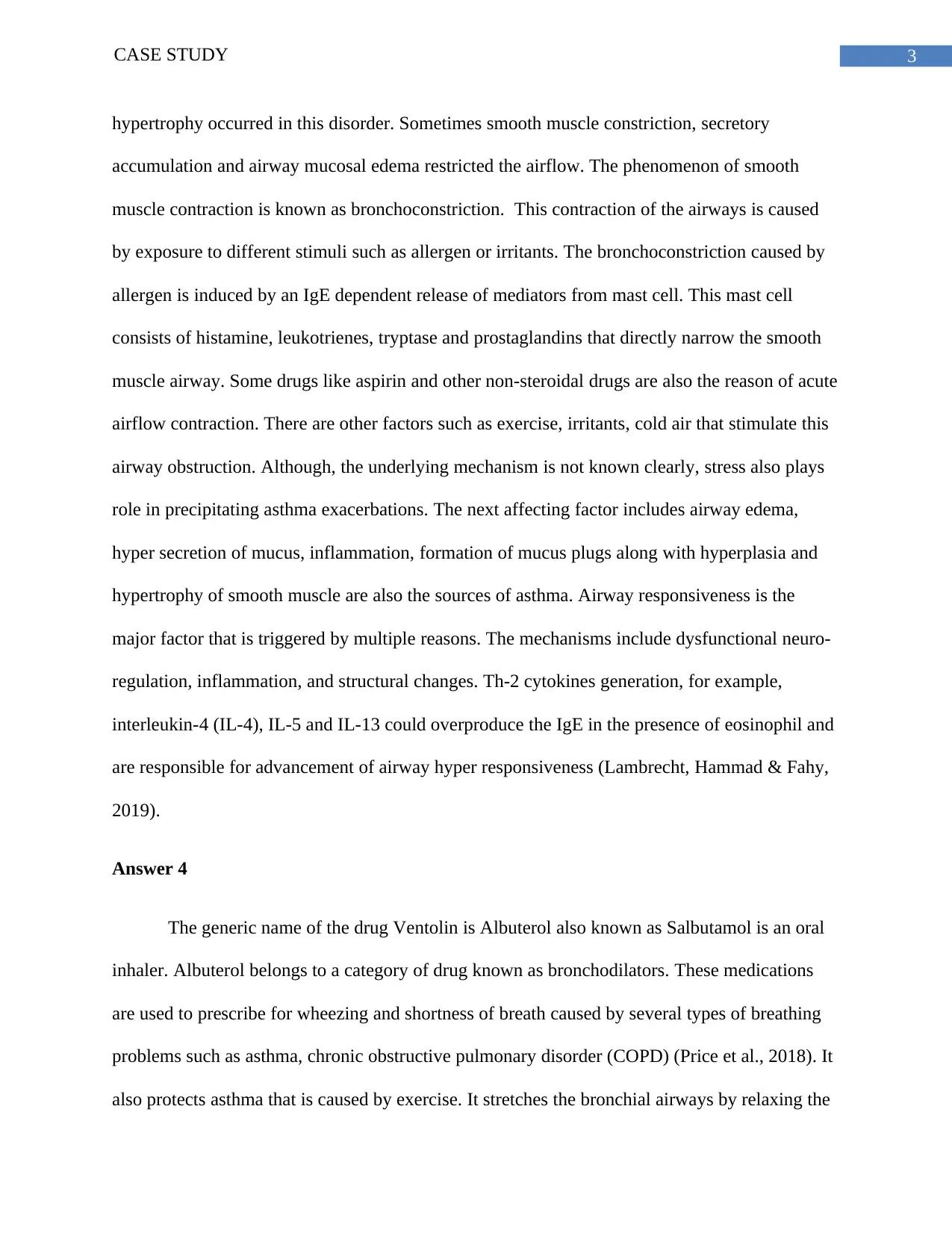
3CASE STUDY
hypertrophy occurred in this disorder. Sometimes smooth muscle constriction, secretory
accumulation and airway mucosal edema restricted the airflow. The phenomenon of smooth
muscle contraction is known as bronchoconstriction. This contraction of the airways is caused
by exposure to different stimuli such as allergen or irritants. The bronchoconstriction caused by
allergen is induced by an IgE dependent release of mediators from mast cell. This mast cell
consists of histamine, leukotrienes, tryptase and prostaglandins that directly narrow the smooth
muscle airway. Some drugs like aspirin and other non-steroidal drugs are also the reason of acute
airflow contraction. There are other factors such as exercise, irritants, cold air that stimulate this
airway obstruction. Although, the underlying mechanism is not known clearly, stress also plays
role in precipitating asthma exacerbations. The next affecting factor includes airway edema,
hyper secretion of mucus, inflammation, formation of mucus plugs along with hyperplasia and
hypertrophy of smooth muscle are also the sources of asthma. Airway responsiveness is the
major factor that is triggered by multiple reasons. The mechanisms include dysfunctional neuro-
regulation, inflammation, and structural changes. Th-2 cytokines generation, for example,
interleukin-4 (IL-4), IL-5 and IL-13 could overproduce the IgE in the presence of eosinophil and
are responsible for advancement of airway hyper responsiveness (Lambrecht, Hammad & Fahy,
2019).
Answer 4
The generic name of the drug Ventolin is Albuterol also known as Salbutamol is an oral
inhaler. Albuterol belongs to a category of drug known as bronchodilators. These medications
are used to prescribe for wheezing and shortness of breath caused by several types of breathing
problems such as asthma, chronic obstructive pulmonary disorder (COPD) (Price et al., 2018). It
also protects asthma that is caused by exercise. It stretches the bronchial airways by relaxing the
hypertrophy occurred in this disorder. Sometimes smooth muscle constriction, secretory
accumulation and airway mucosal edema restricted the airflow. The phenomenon of smooth
muscle contraction is known as bronchoconstriction. This contraction of the airways is caused
by exposure to different stimuli such as allergen or irritants. The bronchoconstriction caused by
allergen is induced by an IgE dependent release of mediators from mast cell. This mast cell
consists of histamine, leukotrienes, tryptase and prostaglandins that directly narrow the smooth
muscle airway. Some drugs like aspirin and other non-steroidal drugs are also the reason of acute
airflow contraction. There are other factors such as exercise, irritants, cold air that stimulate this
airway obstruction. Although, the underlying mechanism is not known clearly, stress also plays
role in precipitating asthma exacerbations. The next affecting factor includes airway edema,
hyper secretion of mucus, inflammation, formation of mucus plugs along with hyperplasia and
hypertrophy of smooth muscle are also the sources of asthma. Airway responsiveness is the
major factor that is triggered by multiple reasons. The mechanisms include dysfunctional neuro-
regulation, inflammation, and structural changes. Th-2 cytokines generation, for example,
interleukin-4 (IL-4), IL-5 and IL-13 could overproduce the IgE in the presence of eosinophil and
are responsible for advancement of airway hyper responsiveness (Lambrecht, Hammad & Fahy,
2019).
Answer 4
The generic name of the drug Ventolin is Albuterol also known as Salbutamol is an oral
inhaler. Albuterol belongs to a category of drug known as bronchodilators. These medications
are used to prescribe for wheezing and shortness of breath caused by several types of breathing
problems such as asthma, chronic obstructive pulmonary disorder (COPD) (Price et al., 2018). It
also protects asthma that is caused by exercise. It stretches the bronchial airways by relaxing the
Paraphrase This Document
Need a fresh take? Get an instant paraphrase of this document with our AI Paraphraser
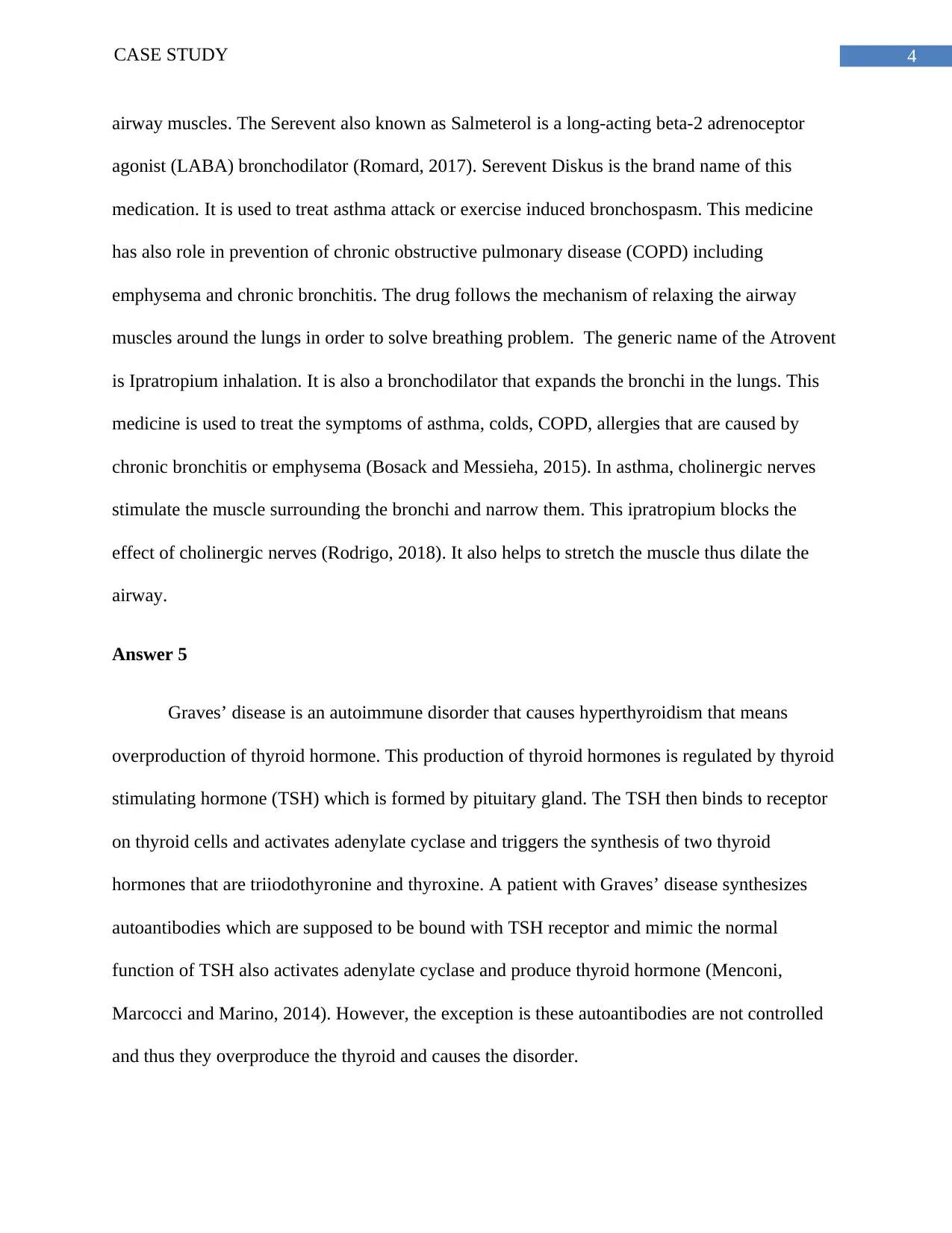
4CASE STUDY
airway muscles. The Serevent also known as Salmeterol is a long-acting beta-2 adrenoceptor
agonist (LABA) bronchodilator (Romard, 2017). Serevent Diskus is the brand name of this
medication. It is used to treat asthma attack or exercise induced bronchospasm. This medicine
has also role in prevention of chronic obstructive pulmonary disease (COPD) including
emphysema and chronic bronchitis. The drug follows the mechanism of relaxing the airway
muscles around the lungs in order to solve breathing problem. The generic name of the Atrovent
is Ipratropium inhalation. It is also a bronchodilator that expands the bronchi in the lungs. This
medicine is used to treat the symptoms of asthma, colds, COPD, allergies that are caused by
chronic bronchitis or emphysema (Bosack and Messieha, 2015). In asthma, cholinergic nerves
stimulate the muscle surrounding the bronchi and narrow them. This ipratropium blocks the
effect of cholinergic nerves (Rodrigo, 2018). It also helps to stretch the muscle thus dilate the
airway.
Answer 5
Graves’ disease is an autoimmune disorder that causes hyperthyroidism that means
overproduction of thyroid hormone. This production of thyroid hormones is regulated by thyroid
stimulating hormone (TSH) which is formed by pituitary gland. The TSH then binds to receptor
on thyroid cells and activates adenylate cyclase and triggers the synthesis of two thyroid
hormones that are triiodothyronine and thyroxine. A patient with Graves’ disease synthesizes
autoantibodies which are supposed to be bound with TSH receptor and mimic the normal
function of TSH also activates adenylate cyclase and produce thyroid hormone (Menconi,
Marcocci and Marino, 2014). However, the exception is these autoantibodies are not controlled
and thus they overproduce the thyroid and causes the disorder.
airway muscles. The Serevent also known as Salmeterol is a long-acting beta-2 adrenoceptor
agonist (LABA) bronchodilator (Romard, 2017). Serevent Diskus is the brand name of this
medication. It is used to treat asthma attack or exercise induced bronchospasm. This medicine
has also role in prevention of chronic obstructive pulmonary disease (COPD) including
emphysema and chronic bronchitis. The drug follows the mechanism of relaxing the airway
muscles around the lungs in order to solve breathing problem. The generic name of the Atrovent
is Ipratropium inhalation. It is also a bronchodilator that expands the bronchi in the lungs. This
medicine is used to treat the symptoms of asthma, colds, COPD, allergies that are caused by
chronic bronchitis or emphysema (Bosack and Messieha, 2015). In asthma, cholinergic nerves
stimulate the muscle surrounding the bronchi and narrow them. This ipratropium blocks the
effect of cholinergic nerves (Rodrigo, 2018). It also helps to stretch the muscle thus dilate the
airway.
Answer 5
Graves’ disease is an autoimmune disorder that causes hyperthyroidism that means
overproduction of thyroid hormone. This production of thyroid hormones is regulated by thyroid
stimulating hormone (TSH) which is formed by pituitary gland. The TSH then binds to receptor
on thyroid cells and activates adenylate cyclase and triggers the synthesis of two thyroid
hormones that are triiodothyronine and thyroxine. A patient with Graves’ disease synthesizes
autoantibodies which are supposed to be bound with TSH receptor and mimic the normal
function of TSH also activates adenylate cyclase and produce thyroid hormone (Menconi,
Marcocci and Marino, 2014). However, the exception is these autoantibodies are not controlled
and thus they overproduce the thyroid and causes the disorder.
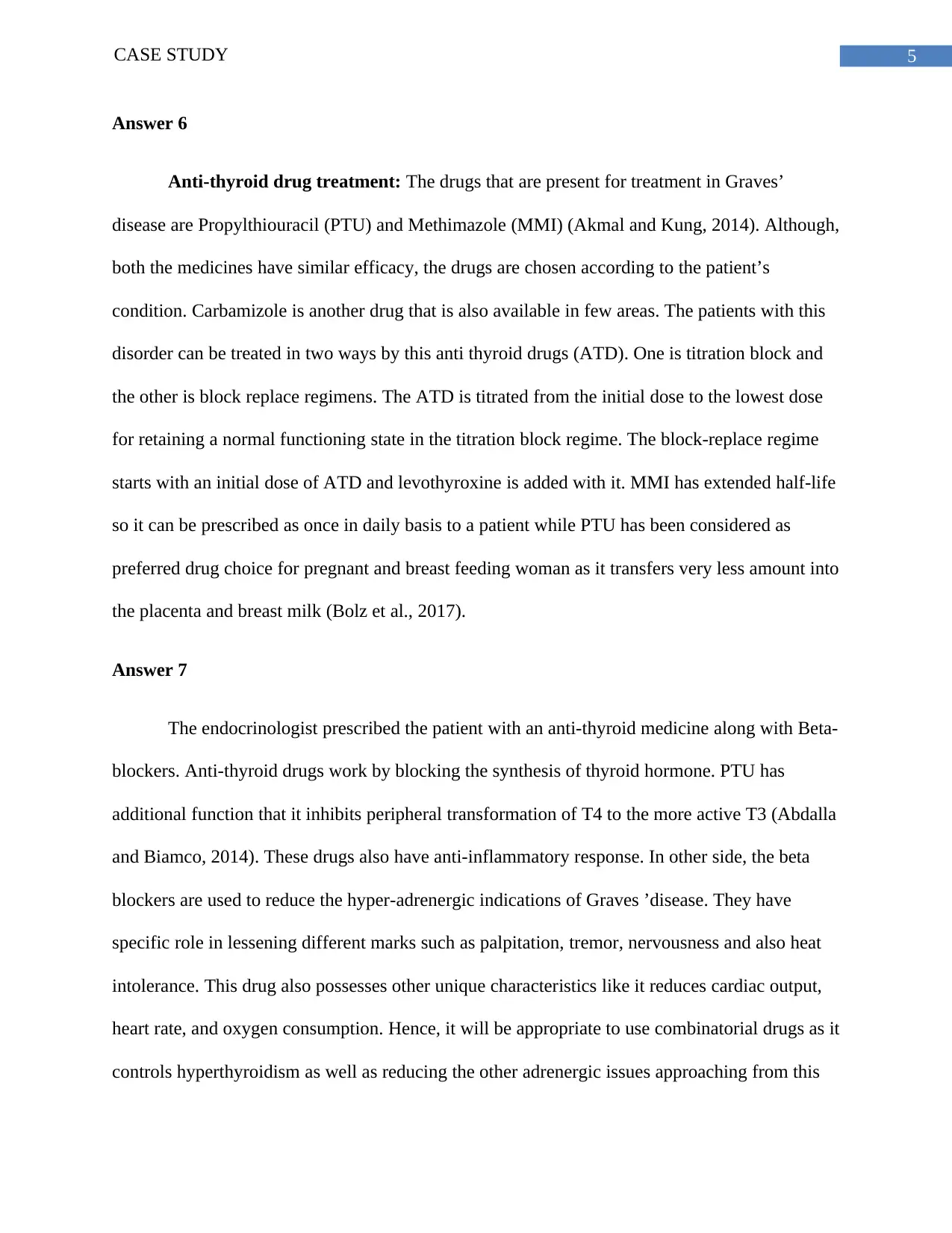
5CASE STUDY
Answer 6
Anti-thyroid drug treatment: The drugs that are present for treatment in Graves’
disease are Propylthiouracil (PTU) and Methimazole (MMI) (Akmal and Kung, 2014). Although,
both the medicines have similar efficacy, the drugs are chosen according to the patient’s
condition. Carbamizole is another drug that is also available in few areas. The patients with this
disorder can be treated in two ways by this anti thyroid drugs (ATD). One is titration block and
the other is block replace regimens. The ATD is titrated from the initial dose to the lowest dose
for retaining a normal functioning state in the titration block regime. The block-replace regime
starts with an initial dose of ATD and levothyroxine is added with it. MMI has extended half-life
so it can be prescribed as once in daily basis to a patient while PTU has been considered as
preferred drug choice for pregnant and breast feeding woman as it transfers very less amount into
the placenta and breast milk (Bolz et al., 2017).
Answer 7
The endocrinologist prescribed the patient with an anti-thyroid medicine along with Beta-
blockers. Anti-thyroid drugs work by blocking the synthesis of thyroid hormone. PTU has
additional function that it inhibits peripheral transformation of T4 to the more active T3 (Abdalla
and Biamco, 2014). These drugs also have anti-inflammatory response. In other side, the beta
blockers are used to reduce the hyper-adrenergic indications of Graves ’disease. They have
specific role in lessening different marks such as palpitation, tremor, nervousness and also heat
intolerance. This drug also possesses other unique characteristics like it reduces cardiac output,
heart rate, and oxygen consumption. Hence, it will be appropriate to use combinatorial drugs as it
controls hyperthyroidism as well as reducing the other adrenergic issues approaching from this
Answer 6
Anti-thyroid drug treatment: The drugs that are present for treatment in Graves’
disease are Propylthiouracil (PTU) and Methimazole (MMI) (Akmal and Kung, 2014). Although,
both the medicines have similar efficacy, the drugs are chosen according to the patient’s
condition. Carbamizole is another drug that is also available in few areas. The patients with this
disorder can be treated in two ways by this anti thyroid drugs (ATD). One is titration block and
the other is block replace regimens. The ATD is titrated from the initial dose to the lowest dose
for retaining a normal functioning state in the titration block regime. The block-replace regime
starts with an initial dose of ATD and levothyroxine is added with it. MMI has extended half-life
so it can be prescribed as once in daily basis to a patient while PTU has been considered as
preferred drug choice for pregnant and breast feeding woman as it transfers very less amount into
the placenta and breast milk (Bolz et al., 2017).
Answer 7
The endocrinologist prescribed the patient with an anti-thyroid medicine along with Beta-
blockers. Anti-thyroid drugs work by blocking the synthesis of thyroid hormone. PTU has
additional function that it inhibits peripheral transformation of T4 to the more active T3 (Abdalla
and Biamco, 2014). These drugs also have anti-inflammatory response. In other side, the beta
blockers are used to reduce the hyper-adrenergic indications of Graves ’disease. They have
specific role in lessening different marks such as palpitation, tremor, nervousness and also heat
intolerance. This drug also possesses other unique characteristics like it reduces cardiac output,
heart rate, and oxygen consumption. Hence, it will be appropriate to use combinatorial drugs as it
controls hyperthyroidism as well as reducing the other adrenergic issues approaching from this
⊘ This is a preview!⊘
Do you want full access?
Subscribe today to unlock all pages.

Trusted by 1+ million students worldwide
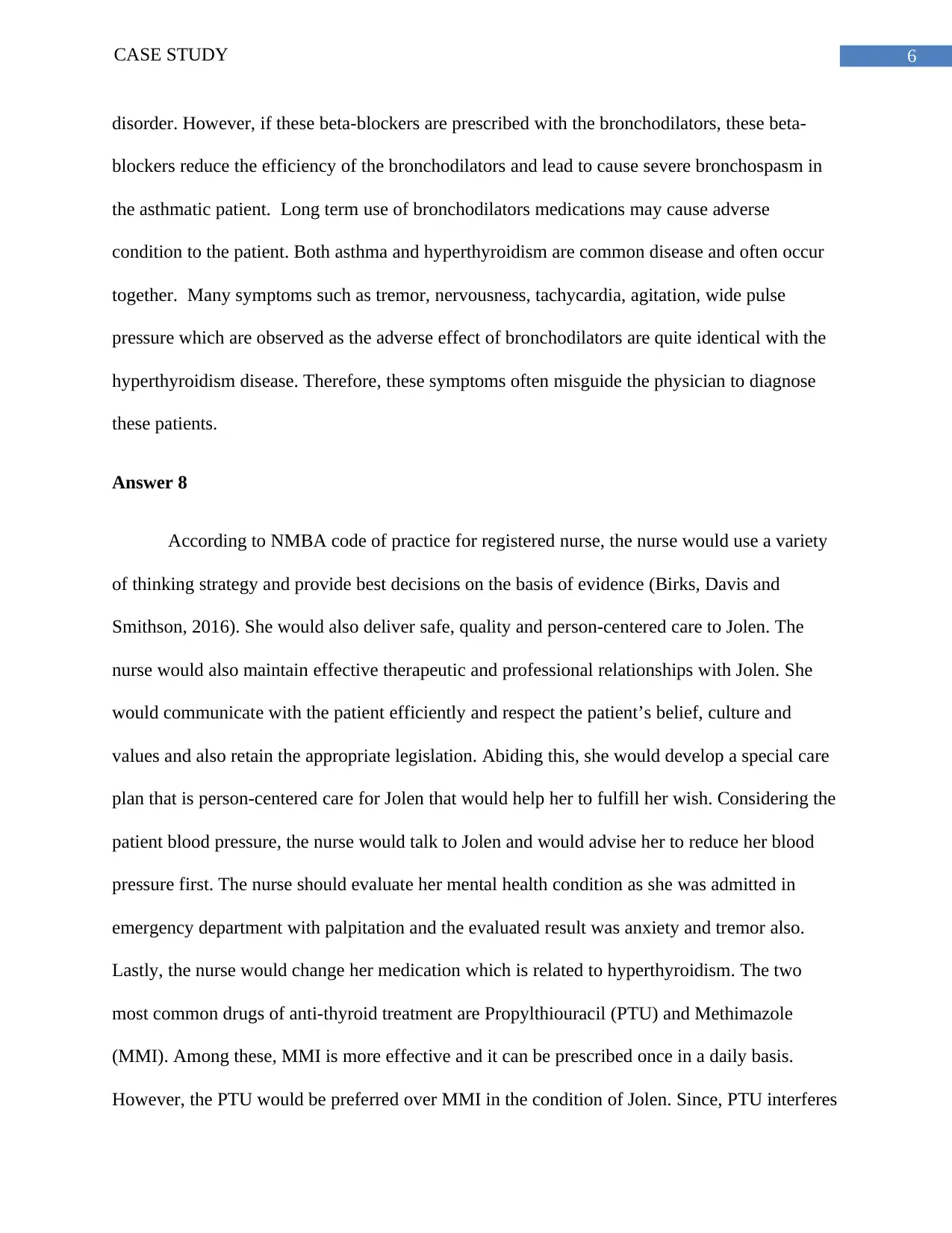
6CASE STUDY
disorder. However, if these beta-blockers are prescribed with the bronchodilators, these beta-
blockers reduce the efficiency of the bronchodilators and lead to cause severe bronchospasm in
the asthmatic patient. Long term use of bronchodilators medications may cause adverse
condition to the patient. Both asthma and hyperthyroidism are common disease and often occur
together. Many symptoms such as tremor, nervousness, tachycardia, agitation, wide pulse
pressure which are observed as the adverse effect of bronchodilators are quite identical with the
hyperthyroidism disease. Therefore, these symptoms often misguide the physician to diagnose
these patients.
Answer 8
According to NMBA code of practice for registered nurse, the nurse would use a variety
of thinking strategy and provide best decisions on the basis of evidence (Birks, Davis and
Smithson, 2016). She would also deliver safe, quality and person-centered care to Jolen. The
nurse would also maintain effective therapeutic and professional relationships with Jolen. She
would communicate with the patient efficiently and respect the patient’s belief, culture and
values and also retain the appropriate legislation. Abiding this, she would develop a special care
plan that is person-centered care for Jolen that would help her to fulfill her wish. Considering the
patient blood pressure, the nurse would talk to Jolen and would advise her to reduce her blood
pressure first. The nurse should evaluate her mental health condition as she was admitted in
emergency department with palpitation and the evaluated result was anxiety and tremor also.
Lastly, the nurse would change her medication which is related to hyperthyroidism. The two
most common drugs of anti-thyroid treatment are Propylthiouracil (PTU) and Methimazole
(MMI). Among these, MMI is more effective and it can be prescribed once in a daily basis.
However, the PTU would be preferred over MMI in the condition of Jolen. Since, PTU interferes
disorder. However, if these beta-blockers are prescribed with the bronchodilators, these beta-
blockers reduce the efficiency of the bronchodilators and lead to cause severe bronchospasm in
the asthmatic patient. Long term use of bronchodilators medications may cause adverse
condition to the patient. Both asthma and hyperthyroidism are common disease and often occur
together. Many symptoms such as tremor, nervousness, tachycardia, agitation, wide pulse
pressure which are observed as the adverse effect of bronchodilators are quite identical with the
hyperthyroidism disease. Therefore, these symptoms often misguide the physician to diagnose
these patients.
Answer 8
According to NMBA code of practice for registered nurse, the nurse would use a variety
of thinking strategy and provide best decisions on the basis of evidence (Birks, Davis and
Smithson, 2016). She would also deliver safe, quality and person-centered care to Jolen. The
nurse would also maintain effective therapeutic and professional relationships with Jolen. She
would communicate with the patient efficiently and respect the patient’s belief, culture and
values and also retain the appropriate legislation. Abiding this, she would develop a special care
plan that is person-centered care for Jolen that would help her to fulfill her wish. Considering the
patient blood pressure, the nurse would talk to Jolen and would advise her to reduce her blood
pressure first. The nurse should evaluate her mental health condition as she was admitted in
emergency department with palpitation and the evaluated result was anxiety and tremor also.
Lastly, the nurse would change her medication which is related to hyperthyroidism. The two
most common drugs of anti-thyroid treatment are Propylthiouracil (PTU) and Methimazole
(MMI). Among these, MMI is more effective and it can be prescribed once in a daily basis.
However, the PTU would be preferred over MMI in the condition of Jolen. Since, PTU interferes
Paraphrase This Document
Need a fresh take? Get an instant paraphrase of this document with our AI Paraphraser

7CASE STUDY
into the placenta in fewer amounts and also in breast milk; it would be more appropriate choice
of drug for Jolen in pregnancy (Kumar, 2016).
into the placenta in fewer amounts and also in breast milk; it would be more appropriate choice
of drug for Jolen in pregnancy (Kumar, 2016).
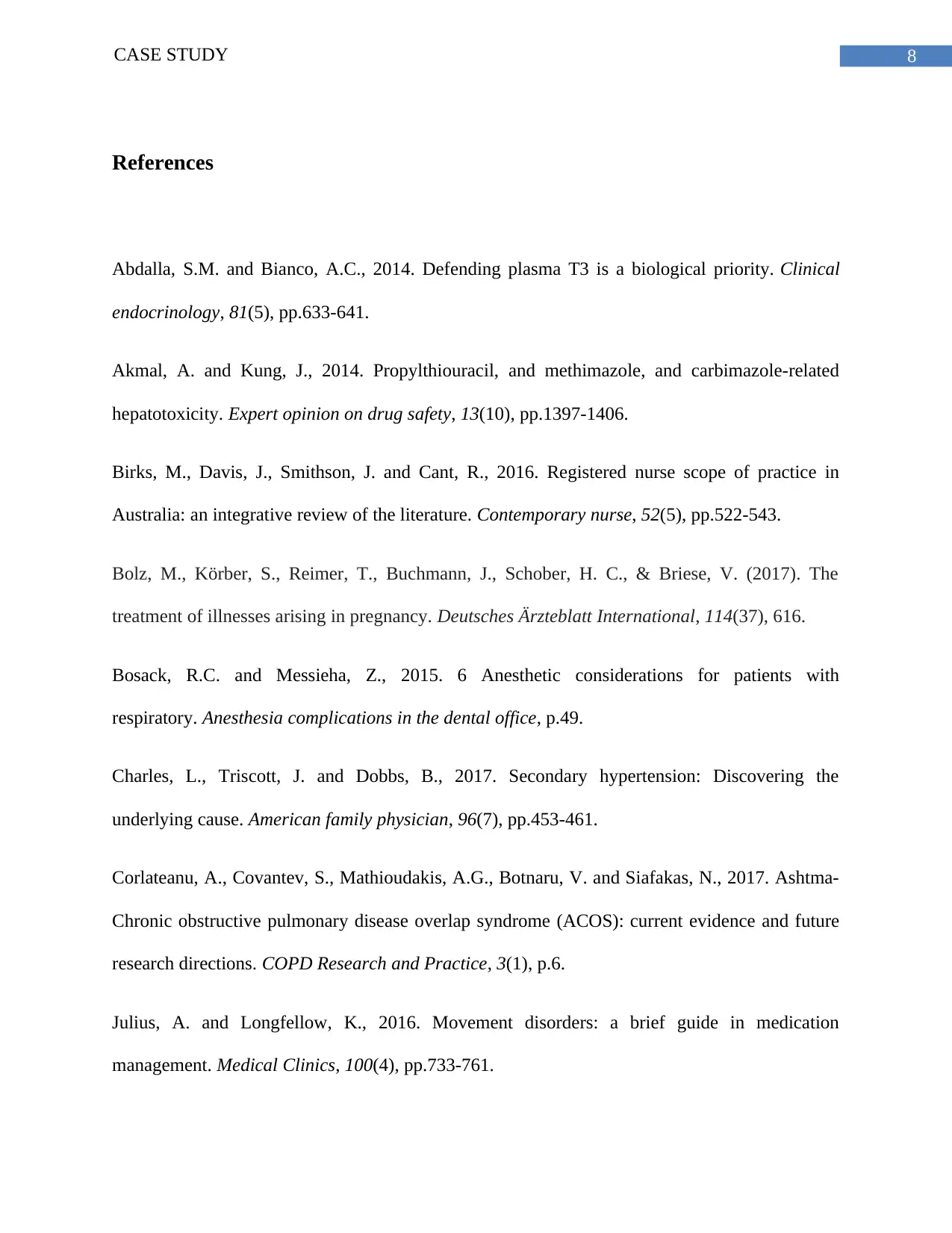
8CASE STUDY
References
Abdalla, S.M. and Bianco, A.C., 2014. Defending plasma T3 is a biological priority. Clinical
endocrinology, 81(5), pp.633-641.
Akmal, A. and Kung, J., 2014. Propylthiouracil, and methimazole, and carbimazole-related
hepatotoxicity. Expert opinion on drug safety, 13(10), pp.1397-1406.
Birks, M., Davis, J., Smithson, J. and Cant, R., 2016. Registered nurse scope of practice in
Australia: an integrative review of the literature. Contemporary nurse, 52(5), pp.522-543.
Bolz, M., Körber, S., Reimer, T., Buchmann, J., Schober, H. C., & Briese, V. (2017). The
treatment of illnesses arising in pregnancy. Deutsches Ärzteblatt International, 114(37), 616.
Bosack, R.C. and Messieha, Z., 2015. 6 Anesthetic considerations for patients with
respiratory. Anesthesia complications in the dental office, p.49.
Charles, L., Triscott, J. and Dobbs, B., 2017. Secondary hypertension: Discovering the
underlying cause. American family physician, 96(7), pp.453-461.
Corlateanu, A., Covantev, S., Mathioudakis, A.G., Botnaru, V. and Siafakas, N., 2017. Ashtma-
Chronic obstructive pulmonary disease overlap syndrome (ACOS): current evidence and future
research directions. COPD Research and Practice, 3(1), p.6.
Julius, A. and Longfellow, K., 2016. Movement disorders: a brief guide in medication
management. Medical Clinics, 100(4), pp.733-761.
References
Abdalla, S.M. and Bianco, A.C., 2014. Defending plasma T3 is a biological priority. Clinical
endocrinology, 81(5), pp.633-641.
Akmal, A. and Kung, J., 2014. Propylthiouracil, and methimazole, and carbimazole-related
hepatotoxicity. Expert opinion on drug safety, 13(10), pp.1397-1406.
Birks, M., Davis, J., Smithson, J. and Cant, R., 2016. Registered nurse scope of practice in
Australia: an integrative review of the literature. Contemporary nurse, 52(5), pp.522-543.
Bolz, M., Körber, S., Reimer, T., Buchmann, J., Schober, H. C., & Briese, V. (2017). The
treatment of illnesses arising in pregnancy. Deutsches Ärzteblatt International, 114(37), 616.
Bosack, R.C. and Messieha, Z., 2015. 6 Anesthetic considerations for patients with
respiratory. Anesthesia complications in the dental office, p.49.
Charles, L., Triscott, J. and Dobbs, B., 2017. Secondary hypertension: Discovering the
underlying cause. American family physician, 96(7), pp.453-461.
Corlateanu, A., Covantev, S., Mathioudakis, A.G., Botnaru, V. and Siafakas, N., 2017. Ashtma-
Chronic obstructive pulmonary disease overlap syndrome (ACOS): current evidence and future
research directions. COPD Research and Practice, 3(1), p.6.
Julius, A. and Longfellow, K., 2016. Movement disorders: a brief guide in medication
management. Medical Clinics, 100(4), pp.733-761.
⊘ This is a preview!⊘
Do you want full access?
Subscribe today to unlock all pages.

Trusted by 1+ million students worldwide
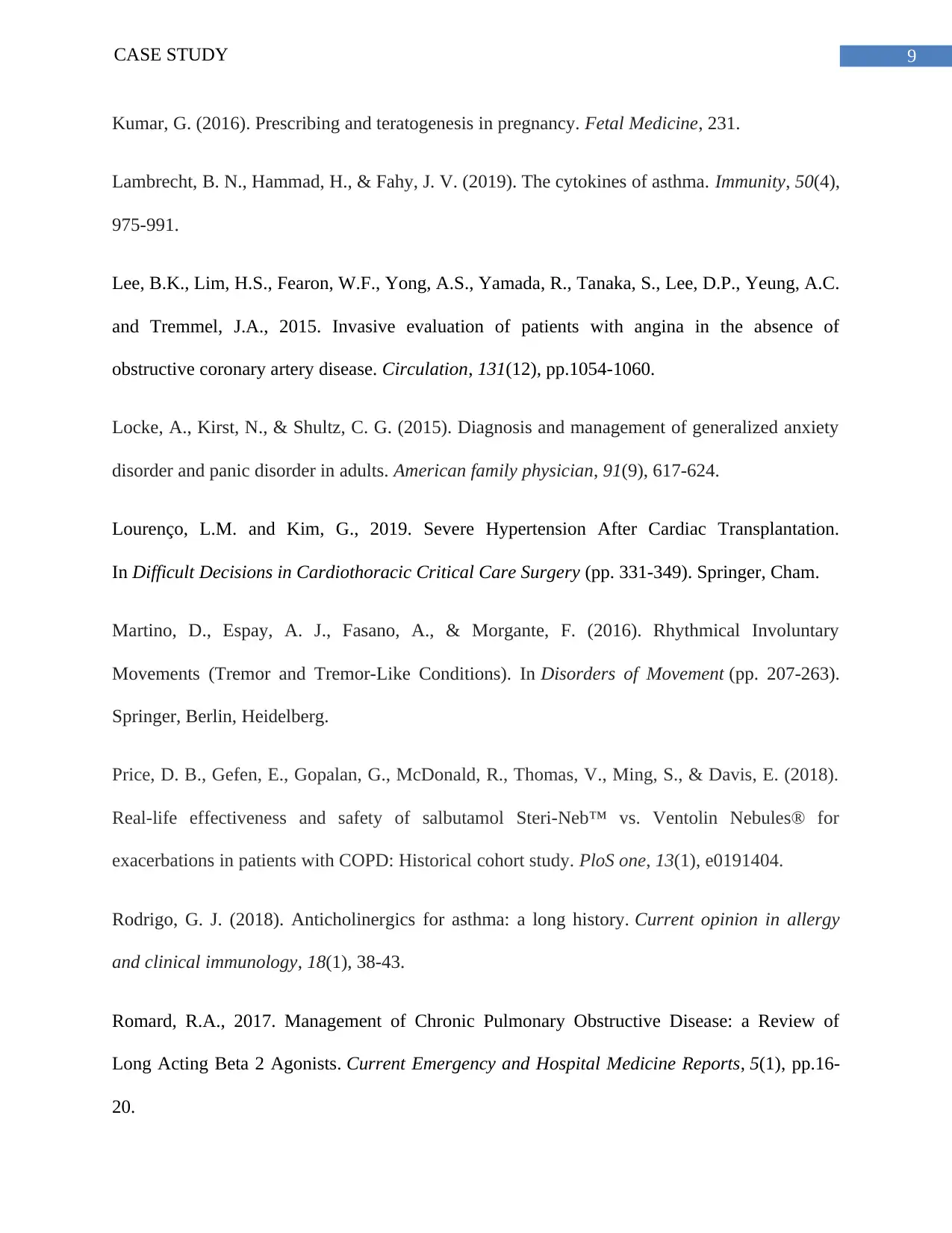
9CASE STUDY
Kumar, G. (2016). Prescribing and teratogenesis in pregnancy. Fetal Medicine, 231.
Lambrecht, B. N., Hammad, H., & Fahy, J. V. (2019). The cytokines of asthma. Immunity, 50(4),
975-991.
Lee, B.K., Lim, H.S., Fearon, W.F., Yong, A.S., Yamada, R., Tanaka, S., Lee, D.P., Yeung, A.C.
and Tremmel, J.A., 2015. Invasive evaluation of patients with angina in the absence of
obstructive coronary artery disease. Circulation, 131(12), pp.1054-1060.
Locke, A., Kirst, N., & Shultz, C. G. (2015). Diagnosis and management of generalized anxiety
disorder and panic disorder in adults. American family physician, 91(9), 617-624.
Lourenço, L.M. and Kim, G., 2019. Severe Hypertension After Cardiac Transplantation.
In Difficult Decisions in Cardiothoracic Critical Care Surgery (pp. 331-349). Springer, Cham.
Martino, D., Espay, A. J., Fasano, A., & Morgante, F. (2016). Rhythmical Involuntary
Movements (Tremor and Tremor-Like Conditions). In Disorders of Movement (pp. 207-263).
Springer, Berlin, Heidelberg.
Price, D. B., Gefen, E., Gopalan, G., McDonald, R., Thomas, V., Ming, S., & Davis, E. (2018).
Real-life effectiveness and safety of salbutamol Steri-Neb™ vs. Ventolin Nebules® for
exacerbations in patients with COPD: Historical cohort study. PloS one, 13(1), e0191404.
Rodrigo, G. J. (2018). Anticholinergics for asthma: a long history. Current opinion in allergy
and clinical immunology, 18(1), 38-43.
Romard, R.A., 2017. Management of Chronic Pulmonary Obstructive Disease: a Review of
Long Acting Beta 2 Agonists. Current Emergency and Hospital Medicine Reports, 5(1), pp.16-
20.
Kumar, G. (2016). Prescribing and teratogenesis in pregnancy. Fetal Medicine, 231.
Lambrecht, B. N., Hammad, H., & Fahy, J. V. (2019). The cytokines of asthma. Immunity, 50(4),
975-991.
Lee, B.K., Lim, H.S., Fearon, W.F., Yong, A.S., Yamada, R., Tanaka, S., Lee, D.P., Yeung, A.C.
and Tremmel, J.A., 2015. Invasive evaluation of patients with angina in the absence of
obstructive coronary artery disease. Circulation, 131(12), pp.1054-1060.
Locke, A., Kirst, N., & Shultz, C. G. (2015). Diagnosis and management of generalized anxiety
disorder and panic disorder in adults. American family physician, 91(9), 617-624.
Lourenço, L.M. and Kim, G., 2019. Severe Hypertension After Cardiac Transplantation.
In Difficult Decisions in Cardiothoracic Critical Care Surgery (pp. 331-349). Springer, Cham.
Martino, D., Espay, A. J., Fasano, A., & Morgante, F. (2016). Rhythmical Involuntary
Movements (Tremor and Tremor-Like Conditions). In Disorders of Movement (pp. 207-263).
Springer, Berlin, Heidelberg.
Price, D. B., Gefen, E., Gopalan, G., McDonald, R., Thomas, V., Ming, S., & Davis, E. (2018).
Real-life effectiveness and safety of salbutamol Steri-Neb™ vs. Ventolin Nebules® for
exacerbations in patients with COPD: Historical cohort study. PloS one, 13(1), e0191404.
Rodrigo, G. J. (2018). Anticholinergics for asthma: a long history. Current opinion in allergy
and clinical immunology, 18(1), 38-43.
Romard, R.A., 2017. Management of Chronic Pulmonary Obstructive Disease: a Review of
Long Acting Beta 2 Agonists. Current Emergency and Hospital Medicine Reports, 5(1), pp.16-
20.
Paraphrase This Document
Need a fresh take? Get an instant paraphrase of this document with our AI Paraphraser

10CASE STUDY
.
.
1 out of 11
Related Documents
Your All-in-One AI-Powered Toolkit for Academic Success.
+13062052269
info@desklib.com
Available 24*7 on WhatsApp / Email
![[object Object]](/_next/static/media/star-bottom.7253800d.svg)
Unlock your academic potential
Copyright © 2020–2025 A2Z Services. All Rights Reserved. Developed and managed by ZUCOL.





